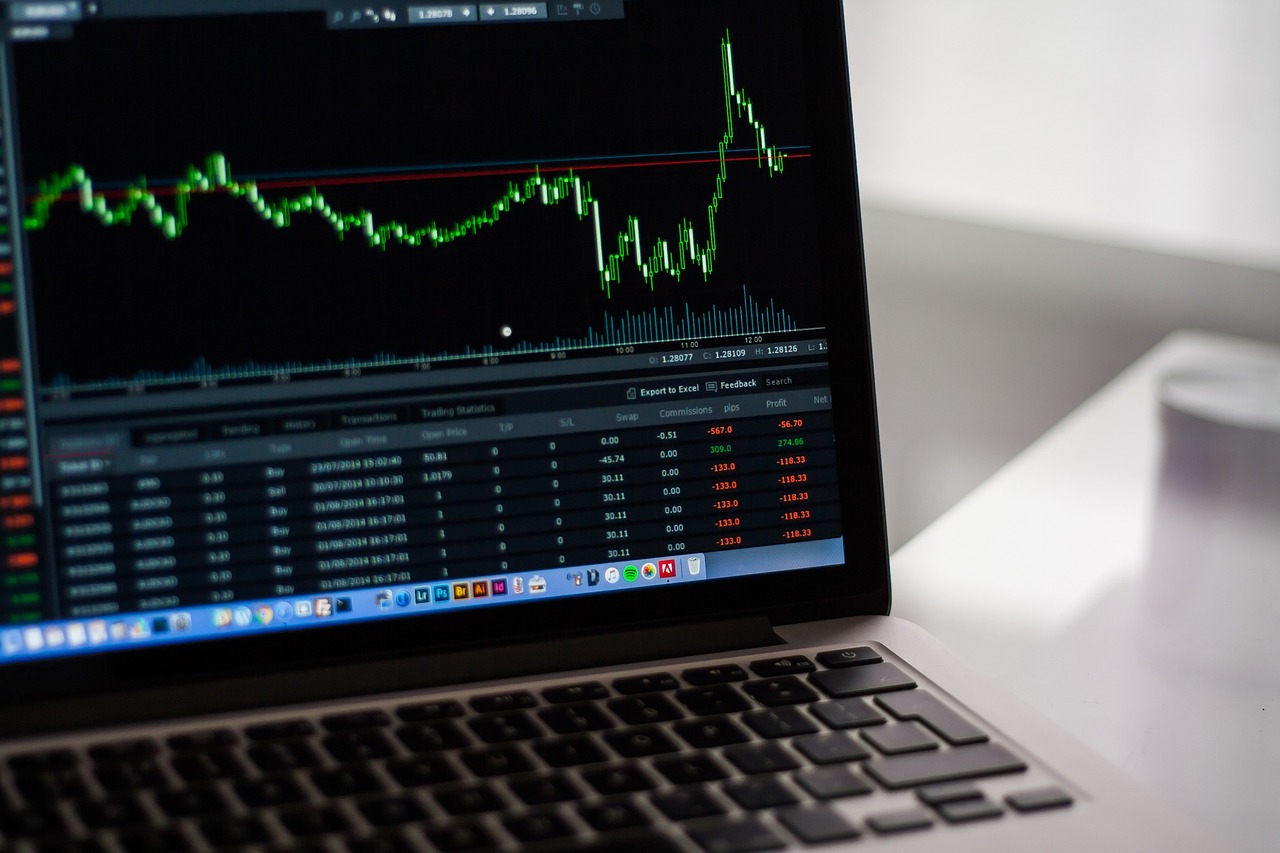Evaluating Market Performance Post-Major Hacks
In today’s digital landscape, where everything from banking to social media operates online, the looming threat of cyberattacks is more real than ever. Major hacks can send shockwaves through the market, impacting not just the companies involved, but also the broader economic climate. So, what really happens when a significant hacking incident occurs? How does it affect investor behavior, market performance, and the overall stability of industries? This article will delve into these questions, providing insights into the ripple effects of cybersecurity breaches and the strategies that can be employed to mitigate their consequences.
When a major hack hits the headlines, it’s not just the affected company that feels the sting. The entire market can react dramatically, often leading to a wave of uncertainty. Investors, driven by fear and speculation, may rush to sell their stocks, leading to a sharp decline in share prices. This reaction is often fueled by a few key factors:
- Investor Sentiment: A breach can shake investor confidence, causing panic selling.
- Market Dynamics: The interconnected nature of markets means that a hack at one company can lead to declines in related sectors.
- Economic Stability: Widespread breaches can raise questions about the security of entire industries, affecting overall economic health.
For example, consider the massive data breach at Equifax in 2017. The fallout was not just a loss of consumer trust but also a significant drop in stock prices, which took years to recover. Such incidents highlight the fragility of market confidence in the face of cybersecurity threats.
Examining notable hacking incidents provides a clearer picture of their immediate and long-term effects on the market. Let's take a closer look at a few significant cases:
| Incident | Year | Immediate Effect | Long-term Implications |
|---|---|---|---|
| Equifax Data Breach | 2017 | Stock price dropped by 35% | Increased regulatory scrutiny, loss of consumer trust |
| Yahoo Data Breach | 2013-2014 | Sale price decreased by $350 million | Impacted Verizon's acquisition strategy |
| Target Data Breach | 2013 | Stock price fell by 10% in a week | Revised security protocols, increased cybersecurity spending |
These case studies reveal not only the immediate market reactions but also the long-term changes in corporate strategies and investor behavior. Companies often find themselves in a delicate balancing act, trying to regain trust while simultaneously addressing vulnerabilities that were exposed during the breaches.
The financial sector is particularly vulnerable to cyberattacks. With vast amounts of sensitive data and significant monetary transactions taking place online, the repercussions of a hack can be catastrophic. A breach in this sector can disrupt operations, leading to:
- Operational Disruption: Systems may go offline, affecting transactions.
- Consumer Trust Erosion: Customers may hesitate to engage with institutions they perceive as insecure.
For instance, the 2016 hack of the Bangladesh Central Bank, which resulted in the loss of $81 million, sent shockwaves through the global banking community, prompting a reevaluation of security measures across the board.
In the wake of significant hacks, regulatory bodies often step in to implement new measures aimed at enhancing cybersecurity. These regulations can take various forms, including stricter compliance requirements, mandatory reporting of breaches, and enhanced penalties for negligence. While these measures aim to protect consumers and stabilize the market, their effectiveness can vary. The challenge lies in ensuring that regulations keep pace with the rapidly evolving cyber threat landscape.
Investors typically respond to hacking news with a mix of fear and caution. Trading patterns can shift dramatically, leading to increased volatility. In the aftermath of a significant breach, you might see:
- Increased Trading Volume: Investors might rush to sell or buy stocks based on perceived value changes.
- Market Volatility: Prices can swing wildly as investors react to news.
Understanding these patterns can help investors navigate the turbulent waters following a hack, allowing them to make more informed decisions.
As the threat of cyberattacks looms larger, companies are investing heavily in technological advancements aimed at bolstering cybersecurity. Innovations such as artificial intelligence, machine learning, and blockchain technology are becoming crucial in protecting sensitive data and maintaining market integrity. These advancements not only help prevent breaches but also reassure investors, fostering a sense of security in an otherwise volatile environment.
Recovering from the adverse effects of major hacks requires a multifaceted approach. Companies must focus on rebuilding trust and financial stability, which can involve:
- Effective Communication: Transparency about the breach and steps taken to mitigate future risks can help restore consumer confidence.
- Investment in Security: Allocating resources to improve cybersecurity measures is essential for long-term recovery.
By taking these steps, companies can not only recover from the immediate fallout of a hack but also position themselves as leaders in cybersecurity, ultimately enhancing their brand reputation.
Brand reputation is a fragile thing, and it can take years to rebuild after a significant breach. Effective communication and marketing strategies play a vital role in this process. Companies must engage with their customers, providing updates on security measures and demonstrating a commitment to protecting their data. This can be likened to a phoenix rising from the ashes; with the right strategies, companies can emerge stronger and more resilient.
Lastly, it's essential to recognize that major hacks can lead to shifts in market trends. Over time, these incidents can influence investor behavior and corporate strategies, leading to:
- Increased Demand for Cybersecurity Solutions: As companies become more aware of their vulnerabilities, the cybersecurity market is likely to grow.
- Changes in Investment Strategies: Investors may prioritize companies with strong cybersecurity measures, altering their portfolios accordingly.
In conclusion, while major hacks can have devastating immediate effects on market performance, they also provide an opportunity for growth and improvement in cybersecurity practices across industries. By understanding the dynamics at play, companies and investors can better prepare for and respond to these challenges.
1. How do major hacks affect stock prices?
Major hacks often lead to a decline in stock prices as investor confidence wanes and panic selling occurs. However, the extent of the decline can vary based on the severity of the breach and the company's response.
2. What steps can companies take to recover from a hack?
Companies can focus on transparent communication, investing in advanced cybersecurity measures, and engaging with their customers to rebuild trust and reputation.
3. Are there regulations in place to protect against cyberattacks?
Yes, various regulatory measures exist to enhance cybersecurity, including mandatory reporting of breaches and compliance requirements. However, the effectiveness of these regulations can vary.
4. How can investors protect themselves during market volatility caused by hacks?
Investors can stay informed about the companies they invest in, diversify their portfolios, and consider the long-term implications of cybersecurity incidents before making decisions.

Understanding the Impact of Major Hacks
In today's digital landscape, the significance of cybersecurity cannot be overstated. Major hacks not only compromise sensitive information but also send shockwaves through the market. When a significant breach occurs, it often leads to an immediate downturn in stock prices, as investors scramble to assess the potential fallout. Investor sentiment can shift dramatically, leading to a phenomenon where fear overrides rational decision-making. Imagine a crowded theater suddenly plunged into darkness; panic ensues, and chaos reigns as everyone rushes for the exits. This is akin to how markets react to hacking incidents.
For instance, when a well-known company falls victim to a cyberattack, its stock may plummet as investors fear for its future viability. The financial repercussions of such incidents can be extensive. Companies may face hefty fines, legal battles, and the cost of repairing their security infrastructure. Moreover, the erosion of consumer trust can lead to a long-term decline in sales, as customers become wary of engaging with brands that have suffered breaches. The ripple effects can extend beyond the affected company, impacting entire industries and even the broader economy.
To illustrate this, let’s consider a few key points that highlight the impact of major hacks:
- Market Volatility: Following a significant breach, markets can experience heightened volatility as traders react to news.
- Investor Behavior: Investors often resort to panic selling, leading to a sharp decline in stock prices.
- Long-term Effects: Companies may take years to recover their market standing, depending on the severity of the breach.
Moreover, the psychological aspect of hacking incidents plays a crucial role. Investors tend to remember the last major hack they heard about, which can create a lingering sense of fear and uncertainty. This can lead to a more cautious approach to investing in companies perceived as vulnerable to cyber threats. The challenge lies in balancing the immediate reactions with the long-term view of a company's potential recovery.
In summary, the impact of major hacks on market performance is multifaceted. From immediate stock price drops to long-term shifts in consumer behavior, the repercussions can be profound. Companies must not only address the technical aspects of cybersecurity but also manage the emotional responses of their investors and customers. As we delve deeper into case studies of notable hacks, we will uncover the intricate ways in which these incidents shape market dynamics.

Case Studies of Notable Hacks
When we think about the digital era, it’s hard to ignore the shadow of major hacking incidents that have rocked various industries. These hacks not only expose sensitive data but also send shockwaves through the financial markets, altering investor sentiment and corporate strategies. Let’s dive into a few notable cases that illustrate this phenomenon.
One of the most infamous hacks occurred in 2017 when Equifax, a leading credit reporting agency, suffered a massive data breach affecting approximately 147 million people. The hackers exploited a vulnerability in Equifax's web application framework, leading to the exposure of social security numbers, birth dates, and other sensitive information. The immediate aftermath saw Equifax's stock price plummet by over 30%, wiping out billions in market capitalization. Investors were left scrambling, and the company faced intense scrutiny, not just for the breach itself but also for its inadequate response.
Another noteworthy incident was the 2014 hack of Sony Pictures, which resulted in the leak of unreleased films and sensitive employee data. This breach was particularly devastating, as it not only impacted stock prices but also led to significant reputational damage. Following the hack, Sony's stock experienced volatility, reflecting investor uncertainty about the company's future. The fallout from this incident prompted a reevaluation of security protocols across the entertainment industry, highlighting how a single breach could reshape entire market perceptions.
In the financial sector, the 2016 hack of Bangladesh Bank serves as a stark reminder of vulnerabilities. Hackers managed to transfer $81 million from the bank’s account at the Federal Reserve Bank of New York by exploiting weaknesses in the SWIFT payment system. This incident raised alarms across global financial markets, leading to a temporary dip in trust towards banking institutions. Investors reacted by reassessing their positions, often pulling back from stocks associated with banks that had not yet fortified their cybersecurity measures.
The financial industry is particularly susceptible to cyberattacks due to the sensitive nature of the data it handles. Breaches can lead to not only immediate financial losses but also long-term damage to consumer trust. For instance, after the Equifax breach, many consumers became wary of sharing their personal information, which in turn affected the business models of companies reliant on data.
In response to these incidents, regulatory bodies have stepped up to implement stricter guidelines. For example, the General Data Protection Regulation (GDPR) in Europe has set a precedent for data protection laws globally. Companies are now required to enhance their cybersecurity measures or face hefty fines. This regulatory shift aims to reinforce consumer trust and stabilize the market, ensuring that companies take proactive steps to protect sensitive information.
Investor reactions to hacking news can be swift and severe. Following a breach, trading patterns often reveal a spike in volatility as investors rush to reassess their portfolios. For instance, after the Equifax breach, many investors opted to divest, fearing that the company's reputation would take years to recover. This behavior underscores the need for companies to not only invest in cybersecurity but also to develop robust communication strategies to keep investors informed during crises.
As we navigate through these turbulent waters, technological advancements in security are becoming paramount. Innovations such as blockchain technology and advanced encryption methods are being adopted to enhance cybersecurity measures. Companies are increasingly investing in artificial intelligence to detect anomalies in real-time, aiming to thwart potential breaches before they escalate. These advancements are crucial in protecting market integrity and ensuring investor confidence.
In summary, the case studies of notable hacks illustrate the profound impact that cybersecurity breaches can have on market dynamics. From immediate financial repercussions to long-term changes in investor behavior and regulatory landscapes, the lessons learned from these incidents are invaluable. As we continue to witness the evolution of technology, it’s essential for companies to remain vigilant and proactive in safeguarding their digital assets.
- What are the long-term effects of a major hack on a company's stock price?
The long-term effects can vary significantly. Some companies may recover quickly if they manage the crisis effectively, while others may see prolonged impacts on their stock prices due to loss of consumer trust and market confidence.
- How can companies prepare for potential hacks?
Companies can prepare by implementing robust cybersecurity measures, conducting regular audits, and training employees on best practices for data protection. Having a crisis management plan in place is also crucial.
- What role do regulators play in the aftermath of a hack?
Regulators often step in to enforce compliance with data protection laws and may impose fines on companies that fail to adequately protect consumer data. They also provide guidelines to help improve industry standards.

Financial Sector Vulnerabilities
The financial sector is often regarded as the backbone of any economy, but it is also one of the most vulnerable industries when it comes to cyberattacks. Why is that? Well, it's simple: the financial sector deals with sensitive information and large sums of money, making it a prime target for hackers. When a breach occurs, the impact can be devastating, not just for the affected institution but for the entire market. Think of it like a house of cards; once one card falls, the others are likely to follow.
One major vulnerability lies in the interconnectedness of financial institutions. Banks, investment firms, and payment processors often rely on shared systems and networks. This interconnected web means that if one entity is compromised, it can create a domino effect, leading to widespread disruption. For example, the 2014 JPMorgan Chase hack exposed the personal information of over 76 million households, sending shockwaves through the financial markets and eroding consumer trust.
Another critical vulnerability is the reliance on outdated technology. Many financial institutions still use legacy systems that are not equipped to handle modern cyber threats. These systems can be like old locks on a door; while they may have worked fine in the past, they are easily bypassed by today’s sophisticated hackers. According to a recent study, over 60% of financial institutions reported that they still use systems that are over a decade old, making them prime targets for attacks.
Moreover, human error plays a significant role in financial sector vulnerabilities. Employees are often the weakest link in cybersecurity. Phishing attacks, where hackers trick employees into revealing sensitive information, are alarmingly prevalent. A report indicated that nearly 90% of data breaches are caused by human error. This is akin to leaving the front door unlocked; no matter how strong your security system is, if the door is open, intruders can easily slip in.
To better understand the vulnerabilities faced by the financial sector, consider the following table that outlines common attack vectors and their potential impacts:
| Attack Vector | Description | Potential Impact |
|---|---|---|
| Phishing | Fraudulent emails designed to trick employees into giving up sensitive information. | Data breach, financial loss, reputational damage. |
| Ransomware | Malware that encrypts data, demanding payment for its release. | Operational disruption, financial loss, potential legal issues. |
| DDoS Attacks | Distributed Denial of Service attacks overwhelm a network, making it unavailable. | Service downtime, loss of customer trust, financial penalties. |
In conclusion, the financial sector's vulnerabilities are multi-faceted and require a comprehensive approach to cybersecurity. Institutions must invest in modern technology, conduct regular employee training, and implement robust security protocols to safeguard themselves against the ever-evolving threat landscape. The stakes are high, and the consequences of inaction can be catastrophic, not just for individual companies but for the economy as a whole. Are we doing enough to protect our financial systems, or are we merely waiting for the next big breach to occur?
- What are the most common types of cyberattacks in the financial sector? The most common types include phishing, ransomware, and DDoS attacks.
- How can financial institutions improve their cybersecurity? By investing in modern technology, conducting regular employee training, and implementing robust security protocols.
- What impact do cyberattacks have on consumer trust? Cyberattacks can significantly erode consumer trust, leading to a loss of customers and revenue for affected institutions.

Regulatory Responses
In the wake of significant cyberattacks, regulatory bodies around the globe have been compelled to act swiftly and decisively. These are essential not only for protecting the financial sector but also for restoring public confidence in the integrity of the markets. The immediate aftermath of a hack often sees a flurry of activity as regulators scramble to assess the damage and implement measures aimed at preventing future breaches. For instance, the Financial Industry Regulatory Authority (FINRA) in the United States has ramped up its scrutiny of cybersecurity protocols, mandating that financial institutions adopt more stringent security measures.
One of the most notable regulatory responses has been the introduction of comprehensive cybersecurity frameworks. These frameworks typically include guidelines on data protection, incident response, and reporting requirements. For example, the General Data Protection Regulation (GDPR) in Europe has set a high standard for data protection, imposing hefty fines for non-compliance that can reach up to 4% of a company's global revenue. This has created a significant incentive for companies to bolster their cybersecurity measures, as the financial repercussions of a breach can be devastating.
Moreover, regulatory bodies have also focused on enhancing transparency in the reporting of cyber incidents. By requiring companies to disclose breaches promptly, regulators aim to ensure that investors are kept in the loop regarding potential risks. This transparency is crucial for maintaining investor trust and market stability. For instance, following high-profile hacks, companies are often required to file reports detailing the nature of the breach, the data affected, and the steps taken to mitigate the damage. This not only holds companies accountable but also provides valuable insights for other organizations looking to strengthen their defenses.
However, the effectiveness of these regulatory responses can vary significantly. Some argue that while regulations are necessary, they can also stifle innovation and create a compliance burden for smaller firms. To balance these concerns, regulators are increasingly engaging with industry stakeholders to develop policies that are both effective and practical. This collaborative approach aims to create a regulatory environment that fosters innovation while ensuring robust cybersecurity practices are in place.
In summary, regulatory responses to major hacks are critical for safeguarding the financial sector and restoring market confidence. As the landscape of cyber threats continues to evolve, so too must the regulations that govern how companies protect their data and respond to incidents. The ongoing dialogue between regulators and industry leaders will be pivotal in shaping a resilient future for the markets.
- What are the main regulatory bodies involved in cybersecurity?
Major regulatory bodies include the Financial Industry Regulatory Authority (FINRA), the Securities and Exchange Commission (SEC), and the General Data Protection Regulation (GDPR) in Europe. - How do regulations impact small businesses?
While regulations aim to enhance security, they can impose significant compliance costs on small businesses, leading to calls for more tailored approaches. - What should companies do after a cyber breach?
Companies should immediately notify regulators, assess the damage, inform affected customers, and implement strategies to prevent future breaches.

Investor Reactions
When a major hacking incident occurs, the immediate reaction from investors can be likened to a roller coaster ride—full of ups and downs, twists and turns that reflect a whirlwind of emotions. Investors often find themselves grappling with uncertainty, leading to a flurry of trading activity that can significantly influence market dynamics. In the wake of a cyber breach, it’s not uncommon to see a sharp decline in stock prices, as panic sets in and the fear of potential financial loss looms large. But why do investors react this way? Well, the answer lies in human psychology and the inherent need for security.
During these tumultuous times, investors often engage in what can be described as herd behavior. When one notable investor decides to sell off shares in response to a hack, others quickly follow suit, creating a domino effect that can lead to a drastic drop in market value. This reaction is fueled by the fear that the breach could lead to significant financial losses or even long-term damage to the company’s reputation. For instance, after the infamous Equifax hack in 2017, the company's stock plummeted by nearly 35% in just a few weeks, showcasing how quickly investor sentiment can shift in the face of cybersecurity threats.
However, not all investor reactions are negative. Some savvy investors view hacking incidents as an opportunity rather than a threat. They may see the potential for a rebound, especially if the company takes decisive action to address the vulnerabilities that led to the breach. In these cases, investors might engage in strategic buying, snapping up shares at lower prices with the hope of capitalizing on eventual recovery. This duality of reaction—panic selling versus opportunistic buying—creates a fascinating dynamic in the market.
To better understand these reactions, it’s essential to consider the broader context of market volatility. Following a major hack, volatility often spikes as traders react to news updates, regulatory announcements, and company statements. This can lead to a period of increased trading volume, as investors try to gauge the long-term implications of the incident. The table below illustrates the typical timeline of investor reactions following a major hack:
| Timeframe | Investor Reaction | Market Impact |
|---|---|---|
| Immediate (0-24 hours) | Panic selling | Sharp decline in stock prices |
| Short-term (1-2 weeks) | Increased volatility | Fluctuating stock prices as news unfolds |
| Medium-term (1-3 months) | Strategic buying by opportunistic investors | Potential recovery if company responds well |
| Long-term (3 months+) | Reassessment of investment strategy | Stabilization or further decline based on recovery efforts |
Ultimately, understanding investor reactions to major hacks is crucial for both companies and stakeholders. It not only provides insight into market behavior but also highlights the importance of effective communication during crises. Companies that manage to convey transparency and a robust recovery plan often find that they can mitigate some of the immediate negative impacts on investor sentiment. As the old saying goes, "A stitch in time saves nine," and timely communication can indeed save a company from further fallout.
- What should companies do immediately after a hack? Companies should prioritize transparent communication with stakeholders and outline their recovery strategy to restore confidence.
- How can investors protect themselves from market volatility after a hack? Diversifying their portfolio and staying informed about company responses can help mitigate risks.
- Are all hacks detrimental to a company's stock? Not necessarily; some investors may see hacks as buying opportunities if the company manages the crisis effectively.

Technological Advancements in Security
In today's digital age, the landscape of cybersecurity is continuously evolving, especially in the wake of major hacks that have rocked various industries. As companies scramble to protect their assets, we witness a surge in technological advancements aimed at fortifying security measures. These innovations not only safeguard sensitive information but also restore investor confidence and market stability. Have you ever wondered how these technologies work and what impact they have on the market? Let's dive into the fascinating world of cybersecurity innovations.
One of the most significant advancements in security technology is the implementation of artificial intelligence (AI) and machine learning (ML)
Another critical development is the rise of blockchain technology. While primarily known for its role in cryptocurrencies, blockchain offers a decentralized approach to data storage and transaction verification that is nearly impervious to hacking. By distributing data across a network of computers, it becomes increasingly difficult for malicious actors to manipulate or access sensitive information. Companies in sectors like finance and healthcare are beginning to adopt blockchain solutions, enhancing their security posture while simultaneously boosting consumer trust.
Moreover, the concept of zero trust security is gaining traction. This model operates on the principle that no one, whether inside or outside the organization, should be trusted by default. Instead, every access request is rigorously verified. This approach is akin to a high-security vault where every individual must prove their identity before entering. By minimizing the risk of insider threats and ensuring that only authorized personnel have access to sensitive data, organizations can significantly bolster their defenses against cyberattacks.
To illustrate the impact of these advancements, consider the following table showcasing various technologies and their benefits:
| Technology | Benefits |
|---|---|
| Artificial Intelligence & Machine Learning | Real-time threat detection, pattern recognition, continuous learning |
| Blockchain | Decentralized data storage, enhanced consumer trust, fraud prevention |
| Zero Trust Security | Minimized insider threats, rigorous access verification, improved data protection |
As we look to the future, it’s clear that these technological advancements are not just trends; they are essential components of a robust security strategy. Companies that invest in these innovations are not only protecting themselves against potential hacks but are also positioning themselves as leaders in their respective industries. The ripple effect of these advancements is profound, influencing market dynamics and shaping the way investors perceive risk. So, the next time you hear about a major hack, remember that behind the scenes, the battle for cybersecurity is being fought with cutting-edge technology.
- What is the role of AI in cybersecurity? AI helps in real-time threat detection and improves security systems by learning from past incidents.
- How does blockchain enhance security? Blockchain offers a decentralized approach to data storage, making it difficult for hackers to manipulate information.
- What is zero trust security? It is a security model that requires verification for every access request, minimizing insider threats.

Market Recovery Strategies
When a major hack rattles the market, companies often find themselves in a tumultuous sea of uncertainty. The immediate aftermath can feel like a storm, with investors panicking and stock prices plummeting. However, it's crucial for businesses to have robust in place to navigate these turbulent waters and steer their way back to stability. One of the first steps is to assess the damage. This involves not just understanding the financial implications but also gauging the emotional impact on consumers and stakeholders. After all, a hack isn't just a technical failure; it's a breach of trust that can take time to mend.
Effective communication is paramount during this recovery phase. Companies need to be transparent about the breach, outlining what happened, how it happened, and what steps are being taken to prevent future incidents. This is not just about damage control; it’s about rebuilding trust. For example, many organizations have found success in hosting town hall meetings or webinars to address concerns directly. By engaging with their audience, they can foster a sense of community and reassurance, which is vital for healing.
Moreover, investing in cybersecurity enhancements is a critical component of recovery. Companies should not only patch the vulnerabilities that led to the hack but also adopt advanced security measures to protect against future threats. This could involve upgrading software, implementing multi-factor authentication, or even engaging third-party cybersecurity firms for audits. In fact, a recent study showed that organizations that invest significantly in cybersecurity post-breach see a faster recovery in stock prices compared to those that do not.
Another effective strategy involves revisiting the company's marketing approach. Following a breach, it's essential to reposition the brand in the eyes of consumers. This may include launching a campaign that emphasizes the new security measures and the company's commitment to protecting customer data. A well-crafted message can turn a negative situation into an opportunity for growth. For instance, companies can highlight their commitment to privacy and security, showcasing testimonials from satisfied customers who appreciate the new measures.
Additionally, companies should consider forming partnerships with cybersecurity firms or industry leaders. These alliances can not only enhance security posture but also provide valuable insights into best practices for recovery. By collaborating with experts, companies can stay ahead of potential threats and reassure investors that they are taking proactive steps to safeguard their assets.
Ultimately, the journey to recovery after a major hack is multifaceted. It requires a blend of transparent communication, strategic marketing, and robust cybersecurity measures. As businesses implement these strategies, they not only work towards restoring their reputation but also pave the way for a more secure future. In this digital age, where cyber threats are ever-present, being prepared can make all the difference between sinking and sailing smoothly.
- What should a company do immediately after a hack? Companies should assess the breach, communicate transparently with stakeholders, and implement immediate security measures to prevent further damage.
- How can effective communication help in recovery? Transparent communication helps rebuild trust with customers and stakeholders, showing them that the company is taking the situation seriously and is committed to improvement.
- What role does cybersecurity play in recovery? Investing in cybersecurity is crucial for protecting against future breaches and demonstrating to investors and customers that the company is serious about safeguarding their data.
- Can a hack lead to positive changes in a company? Yes, while hacks are detrimental, they can also prompt companies to improve their security measures and enhance their overall business practices, leading to long-term benefits.

Rebuilding Brand Reputation
After a significant hacking incident, rebuilding brand reputation is akin to mending a shattered vase. The cracks are there, and while you can glue it back together, the scars will always remain visible. Companies must approach this sensitive task with a well-thought-out strategy that prioritizes transparency and accountability. The first step in this journey is to acknowledge the breach openly. Ignoring or downplaying the situation can lead to a further erosion of trust. Customers today are more informed and connected than ever, and they appreciate honesty. If a company admits to its mistakes and outlines its recovery plan, it can turn a negative situation into an opportunity for growth.
Effective communication is critical in this phase. Companies should utilize various channels to reach their audience, including social media, press releases, and direct communication with stakeholders. This multi-faceted approach ensures that the message is clear and consistent across all platforms. For instance, a company might consider hosting a live Q&A session to address concerns directly, showcasing their commitment to transparency. Such initiatives can help to reassure customers and investors alike, demonstrating that the company is taking the necessary steps to rectify the situation.
Moreover, companies need to invest in enhancing their cybersecurity measures. By implementing advanced security protocols and adopting cutting-edge technology, organizations can signal to their customers that they are serious about protecting their data. This not only helps in regaining trust but also serves as a marketing point. For example, a company might highlight its new security features in its advertising campaigns, turning a negative experience into a positive selling point. This proactive approach can help in reshaping public perception and rebuilding the brand's image.
Another crucial aspect of restoring reputation is engaging with customers directly. Companies can create feedback loops, encouraging customers to share their thoughts and concerns. This not only provides valuable insights into customer sentiment but also fosters a sense of community. When customers feel heard, they are more likely to support the brand in its recovery efforts. Hosting events or webinars to discuss the company's improvements and future plans can further strengthen this relationship. Building a loyal customer base post-crisis is essential, and direct engagement is a powerful tool in achieving this.
Finally, measuring the effectiveness of these strategies is vital. Companies should monitor brand sentiment through social media analytics and customer feedback surveys to gauge public perception over time. This data can help in adjusting strategies as needed, ensuring that the company remains on the right path. In the end, rebuilding brand reputation after a major hack is not just about damage control; it's about creating a stronger, more resilient company that values its customers' trust above all.
- How long does it take to rebuild a brand's reputation after a hack?
Rebuilding a brand's reputation can take months or even years, depending on the severity of the breach and the effectiveness of the recovery strategies implemented. - What are the first steps a company should take after a data breach?
Companies should first acknowledge the breach, communicate transparently with stakeholders, and begin implementing enhanced security measures. - Can a brand ever fully recover from a major hack?
While a brand can recover significantly, the perception of the breach may linger. Continuous effort in maintaining transparency and security is essential for long-term recovery. - How important is customer engagement in rebuilding reputation?
Customer engagement is crucial as it fosters trust and loyalty. Listening to customer feedback can guide effective recovery strategies.

Long-Term Market Trends
The ripple effects of major hacks extend far beyond immediate market reactions; they can significantly reshape long-term market trends and investor behavior. When a high-profile cyber breach occurs, it often serves as a wake-up call for investors and companies alike, prompting a reevaluation of risk management strategies and technological investments. This is akin to a storm that not only disrupts the current weather but also alters climate patterns over time. The aftermath of these incidents can lead to a shift in how companies approach cybersecurity, influencing their operational frameworks and investment strategies.
For instance, after a significant hack, companies often experience a dip in stock prices, reflecting the immediate loss of consumer trust and potential financial repercussions. However, as recovery efforts are initiated and companies demonstrate resilience, the market can rebound. This cycle of decline and recovery can lead to a more cautious investment environment where stakeholders prioritize security measures over rapid growth. Investors may begin to favor companies with strong cybersecurity protocols, leading to a market trend that rewards transparency and robust risk management.
Moreover, the long-term implications of these hacks can lead to increased regulatory scrutiny. Governments and regulatory bodies often respond to major breaches with new legislation aimed at enhancing cybersecurity standards. This can create a ripple effect throughout the industry, compelling businesses to invest in security technologies and compliance measures. As a result, sectors that were previously seen as high-risk may become more stable over time, attracting a new wave of investors who are looking for safer options in the market.
To illustrate this point, consider the following table that outlines the changes in market behavior following notable hacking incidents:
| Hacking Incident | Initial Market Reaction | Long-Term Trend |
|---|---|---|
| Target (2013) | Stock price dropped by 10% | Increased investment in cybersecurity; higher consumer awareness |
| Equifax (2017) | Stock price fell by 30% | Regulatory reforms; surge in demand for data protection services |
| Yahoo (2013-2014) | Stock price fluctuated significantly | Consolidation of tech firms; enhanced focus on user data security |
As we analyze these trends, it becomes clear that major hacks not only disrupt the present but also create a new landscape for the future. Companies that adapt to these changes by prioritizing cybersecurity and transparency are likely to emerge stronger. This evolution in market dynamics emphasizes the importance of resilience and proactive measures in fostering long-term growth and stability.
In conclusion, while the immediate aftermath of a hacking incident may be characterized by volatility and uncertainty, the long-term trends can lead to a more secure and stable market environment. Investors and companies that recognize the value of cybersecurity as a critical component of their operational strategy will be better positioned to navigate the complexities of the modern market landscape.
- How do major hacks affect stock prices? Major hacks typically lead to a decline in stock prices due to loss of consumer trust and potential financial liabilities.
- What long-term changes can we expect in the market after a hack? We can expect increased regulatory scrutiny, a shift in investor behavior towards companies with strong cybersecurity measures, and a general trend towards prioritizing data protection.
- How can companies rebuild their reputation post-hack? Companies can rebuild their reputation by effectively communicating their recovery strategies, enhancing security measures, and being transparent with stakeholders.
Frequently Asked Questions
- What are the common effects of major hacks on market performance?
Major hacks can lead to immediate drops in stock prices, increased market volatility, and shifts in investor sentiment. Companies may face a loss of consumer trust, which can impact their long-term financial stability. In essence, a significant breach can be like a sudden storm, shaking the foundations of even the strongest businesses.
- How do investors typically react to news of a cyberattack?
Investors often react with caution, leading to a sell-off of shares in affected companies. This knee-jerk reaction can create a ripple effect, causing broader market fluctuations. Think of it as a game of dominoes; one fall can lead to many others, impacting investor confidence and market dynamics.
- What strategies can companies use to recover from a hacking incident?
Companies can focus on rebuilding their brand reputation through transparent communication, enhanced security measures, and customer engagement initiatives. It’s crucial to demonstrate to stakeholders that they are taking the necessary steps to prevent future breaches. Imagine it like mending a broken fence; it takes time and effort, but with the right tools, it can be made stronger than before.
- Are there regulatory measures in place to protect against cyberattacks?
Yes, many governments have implemented regulations aimed at enhancing cybersecurity within various industries, especially in finance. These regulations often require companies to adopt specific security protocols and report breaches promptly. However, the effectiveness of these measures can vary, and ongoing adaptation is key to staying ahead of cyber threats.
- What role do technological advancements play in market security?
Technological innovations, such as AI-driven security systems and blockchain technology, are crucial in enhancing cybersecurity. These advancements help in detecting threats more efficiently and protecting sensitive data, ultimately contributing to market stability. Think of technology as a shield; the stronger it is, the better it can protect against potential attacks.
- How can a company effectively communicate with its stakeholders after a hack?
Effective communication involves being transparent about what happened, the steps taken to rectify the situation, and how the company plans to prevent future incidents. Regular updates and open lines of communication can help rebuild trust. It’s like holding a heart-to-heart conversation; honesty goes a long way in restoring relationships.
- What long-term market trends can emerge after significant hacking incidents?
After a major hack, we often see shifts toward greater investment in cybersecurity and a heightened focus on regulatory compliance. Companies may also adapt their business models to prioritize security, which can influence market strategies for years to come. Just like the aftermath of a storm can lead to new growth, the lessons learned from hacks can lead to stronger, more resilient markets.



















